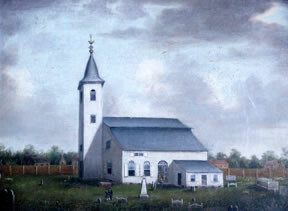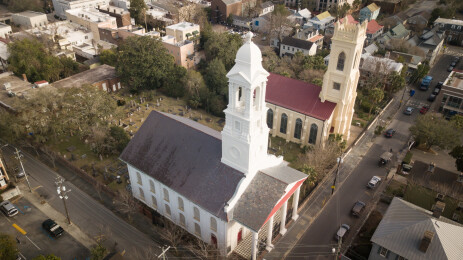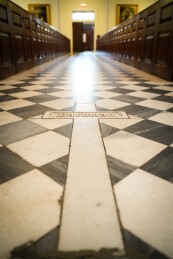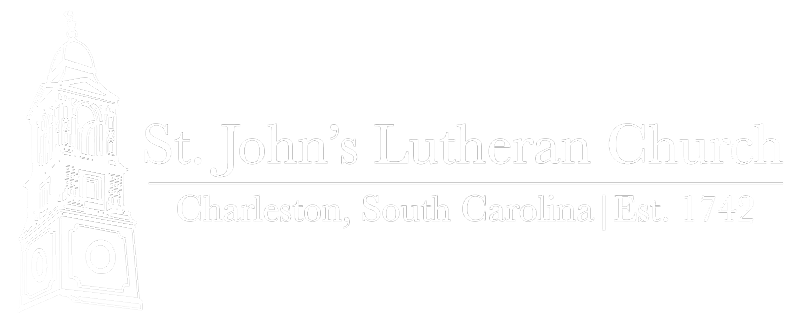The St. John’s congregation dates its origins to the 1742 arrival of Dr. Henry Melchior Muhlenberg, the father of the Lutheran Church in America. He stopped for two days in Charleston on his way to visit the Salzburger colony at Ebenezer, Georgia. He returned a month later and spent three weeks waiting for a ship to Philadelphia during which time he held services, taught catechism to the children of the German residents, and held services with communion on Sundays. Two Georgia Salzberger preachers visited for a few days in 1753 and conducted services and gave the sacraments. Rev. John George Friederichs came in 1755 and organized the congregation. While it appears there were several educated and trained men conducting Lutheran services in South Carolina prior to this time, the organization of the congregation into a formal body and the hiring of a pastor seems to mark the beginning of Lutheranism in South Carolina (HSC).
 Services were held in the French Huguenot Church until the first Lutheran church was completed in 1763. Frederichs left soon after laying the cornerstone of the new church in 1759 and was in turn replaced by Pastor Heinrich Burchard Gabriel Wartmann. Wartmann stayed for two years or less. It has been suggested that while Wartmann was a good speaker and diligent, he had a fiery disposition which seems to have alienated the congregation. Rev. John Nicolas Martin came in 1763. Martin dedicated the new building on June 24, St. John the Baptist Day, 1764. The congregation adopted the St. John’s name at that time. Martin accepted a call to a new church in the interior in 1767.
Services were held in the French Huguenot Church until the first Lutheran church was completed in 1763. Frederichs left soon after laying the cornerstone of the new church in 1759 and was in turn replaced by Pastor Heinrich Burchard Gabriel Wartmann. Wartmann stayed for two years or less. It has been suggested that while Wartmann was a good speaker and diligent, he had a fiery disposition which seems to have alienated the congregation. Rev. John Nicolas Martin came in 1763. Martin dedicated the new building on June 24, St. John the Baptist Day, 1764. The congregation adopted the St. John’s name at that time. Martin accepted a call to a new church in the interior in 1767.
The German Friendly Society was founded in 1766 by Michael Kalteisen and 15 other men, all members of the St. John’s congregation, as a men’s fraternal organization. It has always maintained close ties to St. John’s. The society collected 34 pounds, 5 shillings, and 6 pence to purchase a clock for the church in 1775. The clock was later returned. The church observes a German Friendly Society Sunday, with members of the society walking en masse from their meeting hall on Chalmers Street each year in January.
The internal struggles within the church continued. Rev. John Severin Hahnbaum replaced Martin in 1767, but passed in 1770. The congregation was then taken over by his son-in-law whom he had trained. The new Rev. Daser was quite controversial in the church and the council, and many parishioners, found him to be lacking and was soon discharged, though the church continued to financially support Hahnbaum’s daughter and grandchildren (Muhlenberg). Henry Melchior Muhlenberg came down from Philadelphia in 1774 and was able to unite the factions within the congregation to petition London for a new pastor. Pastor Martin returned from the upcountry to lead the congregation that year, but was expelled by the British two years later in 1776 for his refusal to lead prayers for the king during church services.
Rev. Christian Streit, the nation’s first military chaplain, served as pastor until he was arrested in 1780 for his frequent criticism of the British. Streit is credited with introducing the first English sermons to the church. He did not return after his arrest and served the remainder of his career at a church in Winchester, Virginia. He was replaced at St. John’s by the returning Rev. Daser who remained for five years this time before also removing to Virginia where he too ended his preaching career. Martin was recalled for a second time in 1786. He served as pastor for a year before retiring in 1787. He died in 1797 and is buried in the church burying ground.
Jacob Sass played an important role in shaping the church during this period as congregational president from 1807 to 1836. His twenty-nine year tenure included the hiring of the church’s single most prominent pastor, construction of a new sanctuary, parish building, and numerous other improvements. The loss of church records for this period make it difficult to determine his exact role, but considering the accomplishments made during this period they must have been considerable.
SERVING CHRIST THROUGH THE CENTURIES
The history of St. John’s Lutheran Church spans over 275 years. It is among the oldest congregations of the Evangelical Lutheran Church in America. The charter for the church began as The Lutheran Church for German Protestants in Charleston, but is now commonly know as St. John's Lutheran Church of Charleston, although its official name still carries the title on the charter.
A Lutheran tradition in Charleston may be traced to 1671, when a colony of oppressed Lutherans from Nova Belgia was given land, including a plot for their church. The site of this settlement was on James Island across the Ashley River from the present city. There is no recorded history of these Lutherans or of their church. (See G.D. Bernheim, German Settlements of the Lutheran Church in the Carolinas, pp 56-67)
A Lutheran Communion Service was held for the Charles Towne German Lutherans on May 24, 1734 by the Rev. John Martin Bolzius, pastor of the Salzburger Colony at Ebenezer, Georgia.
Dr. Henry Melchior Muhlenberg, known as the “Father of American Lutheranism”, arrived in Charles Towne in 1742 and records that he worked among the German Lutherans ministering to their needs, leading them in worship, teaching Luther’s Catechism and administering the Sacraments. From these early beginnings the nucleus of St. John’s congregation had its growth.
A petition dated August 7, 1753 was made to the Royal Governor for a parcel of land upon which to build a church. This petition was signed by trustees which would indicate that at that time the church was legally organized. Even though the petition was denied, shortly thereafter during the ministry of Rev. John George Friedrichs (1755-1760), land was acquired. The first church building on the present site was dedicated on St. John the Baptist Day, June 24, 1764 under the name of St. John’s.
The German Friendly Society (1766) was founded by members of the congregation to assist new immigrants and to give aid to the widows and orphans. This society has continued its weekly meetings to this day.
St. John’s pastors and members were active participants in the Revolutionary War. The German Fusiliers, formed by members, fought bravely and with great sacrifice in the siege of Savannah and the defense of Charleston. Pastor John Nicholas Martin was banished from the city in 1778 by the British because he refused to include in the prayer of the Church the required petition for the King of England. The Rev. Christian Streit, who followed Martin, was America’s first denominationally commissioned military chaplain and was arrested in 1780 by the British because of his unwavering devotion to the patriot cause. It was Pastor Streit who first introduced English into St. John’s worship service.
 A “golden era” of St. John’s was the pastorate of the Rev. Dr. John Bachman whose ministry and inspiring influence spanned almost sixty years (1815-1874). The congregation grew rapidly under his dynamic leadership, and in 1818 the present church building was dedicated. Bachman was the powerful force in the founding of the Lutheran Synod of South Carolina (1824). His urgent plea for an educated clergy and the strong support from the St. John’s congregation moved the Synod to establish the Lutheran Theological Southern Seminary (1830) and Newberry College(1856).
A “golden era” of St. John’s was the pastorate of the Rev. Dr. John Bachman whose ministry and inspiring influence spanned almost sixty years (1815-1874). The congregation grew rapidly under his dynamic leadership, and in 1818 the present church building was dedicated. Bachman was the powerful force in the founding of the Lutheran Synod of South Carolina (1824). His urgent plea for an educated clergy and the strong support from the St. John’s congregation moved the Synod to establish the Lutheran Theological Southern Seminary (1830) and Newberry College(1856).
The Ladies Sewing Society (1825) was founded in the congregation for the purpose of giving support to theological education. This Society, remaining faithful to its founding purpose to this day, contributes each year a generous sum to students in the Lutheran Theological Southern Seminary.
Early in his pastorate at St. John’s, Dr. Bachman began a ministry to the black population of the city. By 1860, the black communicant membership of St. John’s had grown to 200 with a Sunday School of 150 pupils taught by a staff of 32 teachers. Bachman tutored three black men:
Jehu Jones Jr., Daniel Alexander Payne and Boston Drayton. Jones organized an independent black Lutheran congregation in Philadelphia. Payne became a bishop in the AME Church and later the president of Wilberforce University in Ohio. Drayton was the first Lutheran missionary to Liberia (1845), and later served as chief justice of the Supreme Court of Liberia and as governor of the African state of Maryland.
Bachman achieved international fame as a scientist in the field of ornithology. He was a personal friend of John James Audubon. Bachman collaborated with Audubon in publishing Birds of America and co-authored with Audubon Quadrupeds of North America.
 St. John’s suddenly passed under the shadow of the War Between the States in 1861. Dr. Bachman delivered the prayer at the Secession Convention praying that the secession might be peaceful; however, the city was soon under fire. The church bell was removed from its tower and melted into gun metal. The church received extensive damage from a direct hit of cannon fire, and the parish building burned. During the war the original sterling communion silver was lost along with Dr. Bachman’s valuable theological and scientific library. Dr. Bachman and his family were persuaded to seek refuge in the upper part of the state. While there he was beaten by a band of Federal troops causing permanent disability to one of his arms. When peace was restored, the stricken pastor returned to the city. St. John’s was the first Charleston church to reopen following the war. Dr. Bachman was buried under the altar of the church.
St. John’s suddenly passed under the shadow of the War Between the States in 1861. Dr. Bachman delivered the prayer at the Secession Convention praying that the secession might be peaceful; however, the city was soon under fire. The church bell was removed from its tower and melted into gun metal. The church received extensive damage from a direct hit of cannon fire, and the parish building burned. During the war the original sterling communion silver was lost along with Dr. Bachman’s valuable theological and scientific library. Dr. Bachman and his family were persuaded to seek refuge in the upper part of the state. While there he was beaten by a band of Federal troops causing permanent disability to one of his arms. When peace was restored, the stricken pastor returned to the city. St. John’s was the first Charleston church to reopen following the war. Dr. Bachman was buried under the altar of the church.
Dr. Edward Traill Horn (1876-1897) was called as pastor in 1876. He was a highly educated man whose character was marked by intellect and a pastoral nature that endeared him to the members. His foresight and energetic ministry would lead St. John’s through the difficult reconstruction years and prepare her to enter the new era of the twentieth century. Dr. Horn initiated the re-design of the chancel of the church with its beautiful Good Shepherd stained glass window which stands as a lasting memorial to his valuable ministry.
In a challenging sermons on April 1, 1883, Dr. Horn advocated the organizing of a Lutheran church in the northern part of the city. The suggestion was accepted and St. Barnabas Lutheran Church came into being.
Dr. Horn was a strong advocate of foreign missions and his persuasive leadership led the South Carolina Synod to establish a Lutheran mission in Japan. The first missionary was The Rev. James A.B. Scherer who was ordained before the altar of St. John’s on November 22, 1891. The first Lutheran worship service was held at Saga City on Kyushu Island, the southern most island of Japan on Easter Sunday, 1893.
The twentieth century was marked by the ministry of Drs. John W. Horine (1897-1907), C. Armand Miller (1907-1912), George J. Gongaware (1913-1941), Heyward W. Epting (1942-1972), C. Armand Shealy (1972-1981), Edward L. Counts (1982-2002), Rev. David J. Butler (2003-2022), and now Dr. Robert Harrell (2024-). During this time many improvements were made to the church properties. The stately historic edifice was artistically restored to its colonial beauty, a spacious parish building was constructed and a new twenty-six rank Schantz organ was installed in 1965 behind the 1823 Thomas Hall case.
The nave was severely damaged by Hurricane Hugo in September of 1989. Repairs and restoration to its original beauty, costing nearly $1,000,000, were completed in May of 1991. Parish building renovations, at a cost of $500,000, were completed in 1996.
St. John‘s celebrated its 250th Anniversary in 1992. At that time, the eighteen-bell Haymaker-Vogelsang Carillon was placed in the steeple replacing the original bell that had been removed during the War Between the States and given to the Confederacy for gunmetal. The pipe organ was enlarged with the addition of six new ranks of pipes including a trompette en chamade.
Another major renovation of the church building was completed in 2011. Improvements included exterior painting, roof repairs, restoration of the windows, the replacement of the heating and cooling systems, a complete electrical rewiring of the church, the installation of new lighting and a heat and smoke detection system. Total cost of these renovations and improvements amounted to expenditures of $800,000.
Twenty-one members from St. John’s have entered the ministry of the church as pastors and other full-time church vocations. Other member of St. John’s have become prominent servants of the city, state and nation.
Today St. John’s beautifully restored sanctuary stands majestically in the heart of Charleston’s historical area. Serving a large vibrant congregation, it is a living witness to over 275 years of ministry and sacrifice from the colonial era to this present day. Entering the 21st century St. John’s stands proudly and strongly at the threshold of a new era, serving with strength to meet the responsibilities of a changing present and a challenging future.
The following have served this church as pastor:
1. John George Friederichs 1755-1760, 2. H. G. B. Wordmann 1761-1762, 3. John Nicholas Martin 1763-1767, 4. John Severin Hahnbaum 1767-1770, (Buried in St. John’s Churchyard)
5. W. Frederick A. Daser 1770-1774, John Nicholas Martin 1774-1778, (Exiled by British)
6. Christian Streit 1778-1780, (Arrested and imprisoned by British), Daser and Martin 1780-1787
7. John Christian Faber 1787-1800, Episcopal Clergy 1800-1805, 8. Matthew F. C. Faber 1805-1811, (Brother of J. C. Faber), Episcopal Clergy 1811-1815, 9. John Bachman 1815-1874, (Buried under Chancel), 10. Thomas W. Dosh 1874-1876, (Assistant to Bachman)
11. Edward Trail Horn 1876-1897, 12. John W. Horine 1897-1907, 13. C. Armand Miller 1907-1912, 14. George J. Gongaware 1913-1941, 15. Heyward W. Epting 1942-1972
(Assistant to Gongaware 1940) (Buried in St. John’s Churchyard), 16. E. Armand Shealy 1972-1981, 17. Edward L. Counts 1982- 2002, 18. David J. Butler 2003 – 2022 19. Robert Harrell 2024-
The following have served as associate pastors: C. Phillip Whitener (1987-1990), Patrick R. Appleget (1993-1995), Ina R. Hoover (1996-1998)
